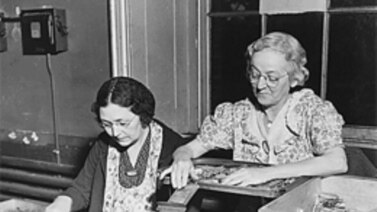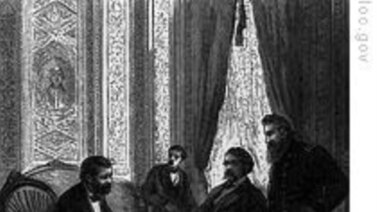
From VOA Learning English, welcome to THE MAKING OF A NATION – American history in Special English. I’m Steve Ember. This week in our series, we continue the story of the United States Constitution.
In May of 1787, a group of America's early leaders met in Philadelphia, Pennsylvania to amend the Articles of Confederation. That document established a loose union of the 13 states. Instead, the leaders wrote a completely new constitution. They created America's system of government and recognized the rights of its citizens.
Last week, we discussed the way the delegates agreed that states would be represented in the national government.
There would be two houses in the legislature. In one house -- the House of Representatives -- the number of representatives from each state would depend on the state's population. In the other house -- the Senate -- all states would have an equal number of representatives.
The agreement on representation was known as the "Great Compromise." Not all the delegates in Philadelphia were pleased with it. But it saved the convention from failure.
The debate on representation in the House raised an important issue. No one wanted to talk about it. But all the delegates knew they had to discuss it. The issue was slavery. There were thousands of slaves in the United States in 1787. Most of them were in southern states. But there were many slaves in the north, too. And northern ship owners made a lot of money by importing slaves from Africa.
A modern-day Supreme Court justice, Clarence Thomas, came from a family whose ancestors included slaves. Justice Thomas says slavery made no sense in America.
“How can you have a free country with slaves? We understood that. It’s a contradiction — it contradicts the very founding premise of the country.”
The Articles of Confederation said nothing about slavery. Each state could decide to allow it or not. Massachusetts, for example, made slavery illegal. Nine other states stopped importing new slaves. Only three states -- Georgia, North Carolina, and South Carolina -- continued to import slaves.
The issue was never easy to discuss. Some of the most important men in America -- including George Washington and James Madison -- owned slaves. No one wanted to insult these men. Yet the delegates at the convention had to make some decisions about slavery.
Slavery affected laws on trade and taxes, as well as the question of representation in Congress. If the number of representatives in the House was based on a state's population, who would you count? Would you count just free people? Or would you count slaves, too?
Akhil Reed Amar, a professor of law and political science at Yale University, calls slavery “the original sin” of America’s founders.
“They inherited it, to be sure, and they worried about it, but not enough.”
During the debate, some delegates argued that slaves were property and should not be counted for purposes of representation. Others argued that slaves were people and should be counted with everyone else.
Gouverneur Morris of Pennsylvania made an angry speech. He denounced slavery as an evil institution.
Charles Pinckney of South Carolina defended the existence of slavery in the United States. "In all ages," he said, "one half of mankind have been slaves."
George Mason of Virginia, a slave owner, wanted to free all slaves. He said Virginia attempted to do that when it was a British colony, but that the British government refused. He blamed the problem on British businessmen who made money from slavery.
Other delegates rose to denounce or defend slavery. But no one at the convention had the power to rule on whether slavery was right or wrong.
Everyone knew the convention would fail if they tried to write a constitution that banned slavery. The southern states would never accept it. They would refuse to be part of the United States.
Rufus King of Massachusetts said the convention should consider slavery only as a political matter. And that was what happened. The delegates accepted several political compromises on the issue.
James Wilson of Pennsylvania, for example, proposed a method of counting each state's population for purposes of representation. All white people and other free citizens would be counted as one person each. Every five slaves would be counted only as three people. This was called the "three-fifths" rule. The delegates accepted it.
The word "slave" was never used in the Constitution. The document simply used the words "all other persons." The three-fifths rule remained the law until the Fourteenth Amendment to the Constitution came into effect in 1868.
Alexander Hamilton said the three-fifths compromise was necessary. Without it, he said, no union could possibly have been formed.
Slavery also became an issue when the delegates began discussing the powers of the national legislature. Once again, the delegates asked: Are slaves people? Or are they property? The answer would affect import taxes and the growth of new states.
The delegates accepted several compromises on these questions, too. They agreed that the treasury could collect a tax of $10 for every imported slave. They also agreed that slaves could be imported until 1808. Then no new slaves could be brought into the country.
Until then, each state had the power to make its own decisions about slavery. After 1808, the national government would make all the decisions.
Constitutional law professor Akhil Reed Amar says that agreement is where the delegates went wrong.
“What was the founders’ biggest mistake? Not that they didn’t get rid of slavery immediately. It was already a part of their world. It would have been difficult to get rid of slavery immediately. But what they didn’t do is come up with a long-term plan to get rid of slavery eventually.”
Debate on the constitution continued through the summer of 1787. At the same time, some of the delegates raised an important question. Once the document was written, who would approve it?
The state legislatures? The people? Or, as Gouverneur Morris proposed, one big national convention? Elbridge Gerry opposed giving that power to the people. "The people," he said, "have the wildest ideas of government in the world."
James Madison disagreed. He believed the people must ratify their new plan of government. Madison considered the difference between a system founded on the legislatures only, and one founded on the people, to be the true difference between a league or treaty, and a Constitution.
When the debate was over, the delegates agreed that the people should ratify the new constitution through conventions held in each state.
Justice Clarence Thomas and law professor Akhil Reed Amar have described this agreement as one of the most remarkable parts of the convention.
“You think of going to Washington and trying to get him to leave Mount Vernon, and he doesn’t want to leave. Because he’s finally back home. He’d been away over four years, and he doesn’t want to leave. And he goes to Philadelphia, and they do it. They come up with this document in, what, four months. And now you have it. It’s going to the Congress, and it’s going to be sent to the people to … "
"To the people."
“To the people, to ratify."
“Amazing.”
Finally, the delegates had to decide how many "yes" votes by states would be needed to ratify the constitution.
Any changes to the Articles of Confederation needed ratification by all 13 states. The Philadelphia convention was called only to change those articles, not to replace them. So all 13 states would have to approve. But several delegates said this would be impossible. After all, Rhode Island never sent a representative to Philadelphia. That state was sure to reject the constitution.
Also, as everyone knew, the Philadelphia convention went far past the point of changing the Articles of Confederation. The delegates wrote a completely new plan of government. But that meant they could agree to accept ratification by fewer than 13 states.
Delegates who supported a strong central government wanted to quickly put the question to a vote. How many states were needed to ratify? By the end of the day, the convention had not decided. But early the next day, the delegates voted, and the number they agreed on was nine.
The convention in Philadelphia was nearing the end of its work. The delegates needed only to write out their agreements in final form and sign the document. That will be our story next week.
This was program #20.

